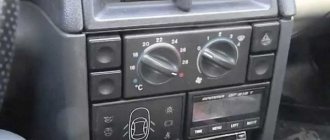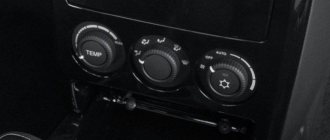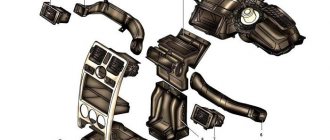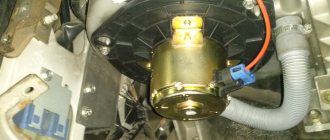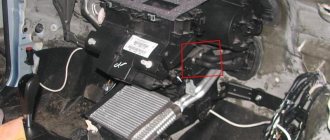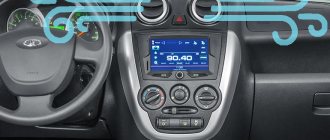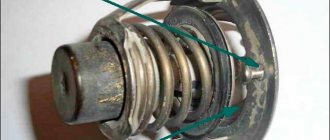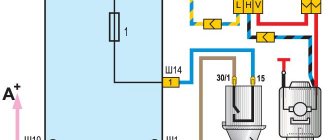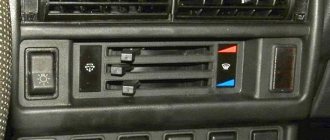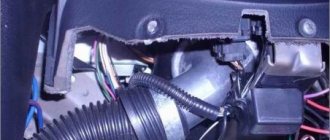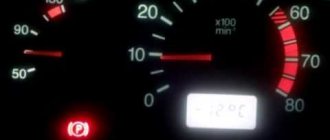September 17, 2015 Lada.Online 110 180 11
The Lada Priora is in many ways similar to its progenitor, the VAZ of the tenth family, including the design of the heater. The manufacturer decided to leave the operating principle of the stove, replacing only some elements with new ones. At the same time, Lada Priora also inherited familiar problems, for example, when the stove does not heat and blows cold air.
Heating system elements (stoves)
The fact that the Priora stove is 95% similar to the “ten” can be seen by the catalog numbers:
- Heater assembly (2170-8101012 or 2111-8101012-10).
- Air flow distribution gearmotor (2170-8127100). Distributes air flow to the feet/face/windshield. Located inside the dashboard.
- Interior air temperature sensor (11186-8128050). Located on the ceiling.
- Heater control controller (HCU) or stove control unit (21703-8128020). The block on which the driver sets the operating parameters of the stove. Located on the panel.
- Additional resistor or additional resistor (2123-8118022). Determines the rotation speed of the stove fan. Secured in the engine compartment.
- Electric heater fan (2111-8118020). Located under the hood.
- Heater damper motor reducer (2110-8127200). Distributes air flows into the cabin (outside/heater radiator). Inside the heater assembly.
- Air filter (2110-8122020).
- Heater radiator (2110-8101060). Located inside the heater.
A malfunction of one of these elements causes problems in the operation of the stove.
No heating at idle
It is not for nothing that this issue has been submitted for separate consideration, since it worries many motorists and solving the problem can be much more difficult than one might expect. So, you have a Priora, the heater does not heat up at idle, although when the car is moving, the interior is heated in normal mode. Here you can also identify several possible reasons:
- Insufficient coolant level.
- Leaks that lead to a decrease in antifreeze levels.
- There is an air lock in the system.
If the first two problems can be easily diagnosed and eliminated, then with an air lock the situation is much more complicated. If you have ruled out the first two reasons and the Priora’s stove still does not heat up at idle, you need to eliminate the air lock. You must proceed as follows:
- We remove the screen from the engine.
- We lower the clamp, after which it is necessary to remove the heating tube for the throttle assembly. We choose any of the two.
- Unscrew the cap on the expansion tank. We place a clean rag on the neck and begin to blow into the expansion tank. The air supply should be carried out until coolant begins to pour out of the tube, which was previously removed.
- Immediately place the tube on the fitting and carefully tighten the clamp.
- Installing the screen.
If the option of blowing out the tank does not suit you, then you can go another way. We warm up the engine so that the pressure in the heating system increases. After some time, we turn off the car and remove the hose from the heating of the throttle assembly. In this case, there is no need to remove the cap from the tank. As a result of high pressure, coolant will be forced through the tube. All that remains is to place the tube on the fitting and tighten the clamp.
Now the Priora stove should not cause any difficulties; you know how to fix faults, as well as carry out diagnostics and identify the source of the problems. Let the heater in your car always turn on, work properly and provide comfort regardless of the weather outside.
Operating principle of the stove
To independently determine a heater malfunction, you should understand the principle of its operation.
The heater control controller receives a signal from the temperature sensor in the cabin and compares it with the temperature set by the driver. If there is a difference, then the KUO sends a signal to the heater gear motor (located under the hood) so that it closes or opens the heater dampers by a certain amount for a greater supply of cold or hot air.
After setting the required heater fan speed, the heater control controller sends a signal to an additional resistor (in the engine compartment), which, due to the built-in resistance, sends an adjusted signal to the fan. At maximum speed, the resistor is not used and the electric fan rotates at maximum speed.
The air direction (face/legs/windshield) is determined by the driver by setting the required value on the control unit. After this, the signal is sent to the air flow distribution gearmotor (inside the panel/dashboard), which moves the flaps in the desired direction.
We carry out comprehensive diagnostics
Removing a faulty heater from a Lada Priora is not so easy. Even experienced motorists cannot cope with this task quickly. To avoid doing such a large amount of work in vain, it is better to first diagnose the heating system. You must proceed as follows:
- We probe the channels through which the coolant flows to the heater. They should be warm when the stove is on. In addition, when pressing on the main rubber hoses, resistance should be felt. If resistance is not felt, the pump pump may be faulty. This mechanism is responsible for creating the pressure of fluid flows necessary for normal operation of the heater.
- A little secret that may be useful to Lada Priora owners: does the stove blow cold air for a long time and does not warm up as quickly as we would like? Then you can try filling coolant to the bottom mark in the tank. In this case, the liquid will warm up faster. If you practice this method, you will need to constantly check the coolant level.
- If a running heater is a source of noise, then we can talk about a problem in the bearing, which is located on the electric fan. This situation cannot be ignored, since in the future the fan may jam and repairs will take place on a much larger scale.
- Is the stove not working? Perhaps the problem is hidden in fuse F9 with a rating of 25 A. Its function is to protect the power electrical lines of the heater. A blown fuse must be replaced. If such a situation occurs with enviable consistency, then it is necessary to check all electrical circuits of the heater, the insulation of the windings on the fan and the presence of an overload in the power circuit.
If the stove blows cold air (does not heat)
There may be several reasons why the Priora’s stove does not heat well (the percentage of breakdowns based on the results of a survey among owners of this car is indicated in parentheses):
- There is a malfunction in the engine cooling system (the heater radiator is cold and cannot give off heat). Touch both heater core hoses; they should both be hot. Sometimes the reason lies in the radiator itself (defect, insufficiently productive) (8%).
- Dirty cabin filter. Try removing the filter for a while and checking the operation of the stove (2%).
- The heater damper does not work, it is simply jammed (17%).
- The heater gear motor is faulty (16%).
- The heater control unit is faulty (13%).
- The interior air temperature sensor is faulty. Try turning it off for a while and check the operation of the heater (6%).
Points 3-6 may also be the reason when only hot air is constantly blowing from the stove.
The Lada Priora stove does not heat well with or without air conditioning
Nowadays, a Lada Priora equipped with an air conditioning system will not surprise anyone. Air conditioning is an additional installation that increases the cost of the car. It may be included in the package, or it can also be purchased after purchasing the car. This car only recently became equipped with air conditioning.
When buying a car, it’s worth considering whether air conditioning is needed in the kit. Suppliers of air conditioners for this car are Panasonic made in Taiwan or Korean Hello. These two types of air conditioners with their parts were developed by contractors and look basically the same in appearance. When replacing a filter or belt in an air conditioner, you need to know its model and filter size.
The stove does not turn on
In a situation where the Priora stove does not turn on, there may be two explanations - a blown fuse, a blown fan motor, a breakdown of the controller, or oxidation of the contacts in the connectors.
After checking the fuse, take the following steps:
- Open the hood and on the left side (looking at the windshield) remove the rubber seal at the top left.
- Remove the four screws to remove the trim.
- Find the heater connector somewhere near the third mount.
- Turn on the ignition.
- Try to press the connector and pay attention to whether the stove starts working or not.
Damage to the connector is a real problem on the Priora, so do not rush to immediately change the control unit or other elements before checking the fuse and the quality of the contact connection.
Control unit failure
The weak point of the Priora stove is the control unit (controller). The functions of this device include air distribution, creating airflow activity in different zones, as well as maintaining optimal temperature inside.
If the unit fails, the stove will also not function, because it will lose its control body.
Before replacing the controller, check the serviceability of the regulator installed on the front panel, because the control unit rarely breaks down.
To avoid wasting extra money, find a known-good controller, install it in place of the current one, and check that the furnace is working properly. If the heater still does not work, look for a breakdown elsewhere.
To check whether the gearmotor is controlled by the control unit, remove the latter. Find the brown and pink and green wires (they control the gear motor). Measure the voltage on them.
To do this, connect a multimeter to the wires in 20V mode. Turn on the ignition and turn the control to hot and cold modes.
In the hot position, the multimeter should show around 10V, in the cold position - minus 10V. Those. the gearbox is controlled.
If the wires are connected in a different polarity, the readings will be opposite.
The stove does not heat, six main reasons. What to do
Today a very relevant article (especially in winter) is that the car’s heater does not heat, or heats very poorly! Why does this happen and what are the main reasons for this? After all, a normal working car should warm up the interior within 10 - 15 minutes (unless, of course, you have a turbocharged engine, there is a partial solution for that here ). If after 15 minutes you have barely warm air (or not at all), and all the glass inside is frozen, then this is not “good”! Read my tips below...
First, let's think about how a car warms up? As we all know, during operation the internal combustion engine heats up very much, this happens from the friction of the pistons against the cylinder walls, as well as from the combustion of the fuel mixture. If you do not cool the engine, it will quickly fail (the pistons will simply jam). A whole cooling system has been made from pipes, pipes and radiators, which prevents the power unit from overheating. So one of the radiators is located inside the cabin, under the instrument panel.
Without going into complex technical details, this heater radiator (warmed up by engine coolant) warms up your interior. And in order for the heating efficiency to increase significantly, there is a fan nearby (which has several operating modes, faster - slower) that blows on this radiator, due to which warm air flows intensively into the cabin (both on the windows and on passengers). And if something disrupts this work process, then cold air enters the cabin, that is, the stove does not heat.
Now let's talk about the main reasons
There are about five reasons for poor warming up.
Fan doesn't work
The most common reason, it happens, is that the fan does not work, it simply does not blow, and, accordingly, warm air does not flow well into the cabin, or rather does not flow at all. Of course, the heater radiator will heat up, but for heating the entire cabin, this is extremely insufficient.
The fan or the electronics that control it need to be replaced. Or look at the fuse, often it simply blows and needs to be replaced .
Insufficient coolant level
This is now unlikely, because many modern cars have antifreeze level sensors. However, such cases do occur (say, in cars of previous generations). Imagine - the antifreeze or antifreeze (maybe due to leaking radiators or pipes), the stove does not receive enough heated liquid, and it is practically cold, the fan is blowing, and the air is cold (it simply does not heat). You need to add coolant to the level ( read how to do this here ). Also, if radiators or pipes are leaking, then the leak must be eliminated.
Recommendations: how to avoid stove failure in Lada Priora
In order for the stove to work without interruptions and breakdowns, you must adhere to the following rules:
- regularly clean the radiator with a stream of compressed air, a vacuum cleaner, or remove and rinse with a stream of water;
- it is advisable to replace antifreeze at least once a year, since low-quality antifreeze creates growths inside the pipe channels that can be washed with citric acid or a special liquid;
- a thermostat malfunction must be urgently replaced; if it is stuck open, then major repairs are guaranteed;
- if the cabin filter is clogged, it must be replaced with a new one; if air bubbles form, you should try to expel the air with the engine off or allow the car to idle;
- monitor the damper control levers on the stove;
- It is necessary to periodically clean the dust and lubricate the bearings on the stove fan.
Over the entire period of its existence, the Lada Priora has been constantly improved. More and more new models are appearing.
For example, a Priora hatchback car has the maximum equipment: ABC, climate control, heating, parking sensors, standard music and much more. Its advantages are a fast engine, fuel consumption, reliability, a good stove and starts in any frost. The seat behind the wheel is very comfortable - your back doesn’t get tired and your legs don’t get numb. Previously, the Lada Priora had one engine - a 16-valve engine producing 98 horsepower. Now Lada Priora consists of two 16 valves and produces 98 and 106 horsepower.
Solving the problem of poor heating by the stove on the Lada Priora
› Air system ›
14.04.2017
If the stove in the car does not heat well (we are most interested in the Priora at this moment), then this situation causes a lot of inconvenience to the driver and passengers. In the summer, this problem is not relevant, because no one really worries about the condition of the heater. And only with the onset of cold weather does the overwhelming number of motorists become puzzled by the problem of a non-working heating system.
Possible reasons for cold air supply
A common situation is when cold air blows from the Priora stove; there may be more than one reason for this. It is in identifying the malfunction that the main problem lies. There may be several reasons why the stove on a Priora does not blow:
- A breakdown of the engine cooling system is the most common problem. This is where diagnostics should begin. In most cases, the stove on a Priora does not turn on precisely for this reason.
- A heavily dirty cabin filter that should be replaced with a new one. This procedure should be performed every six months, without waiting for the moment when the stove starts blowing cold air.
- The stove on the Priora is not blowing well, possibly due to the damper, which may be stuck. It may not open completely, thus blocking the path of hot air flows.
- The problem may also lie in the gearmotor. It is necessary to check its functionality.
- If the stove on a Priora does not work as you would like, then you should pay attention to the control unit.
- The temperature sensor can also have a negative impact on the performance of the heating system. To determine this point, you will need to turn off the sensor and see how the heater behaves.
